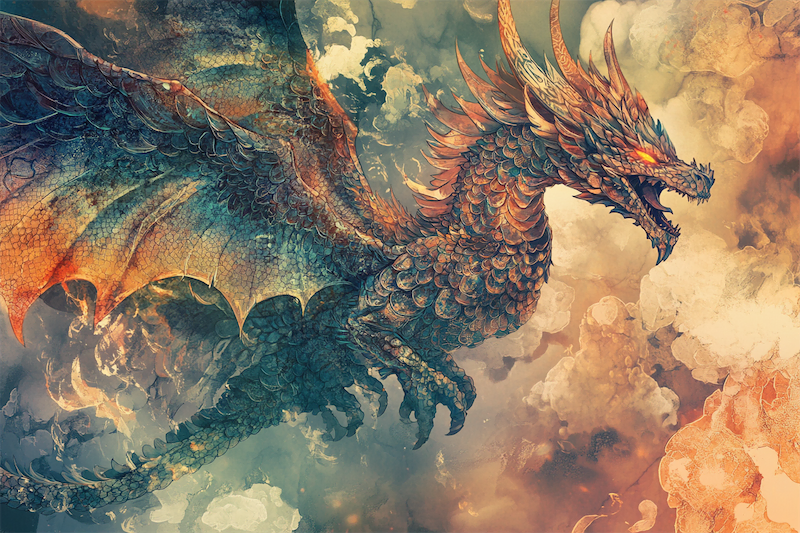What Is a Dragon?
The dragon is one of the most influential mythical creatures in human culture. Dragons appear in almost every major civilization across the world, from the mystical East to the mysterious West. Each culture has its own way of depicting dragons, along with unique beliefs, stories, and symbolism, creating a rich diversity in the creature’s appearance, personality, powers, and meaning.
In Western cultures, dragons are often portrayed as giant, winged beasts that breathe fire. They symbolize destruction and greed, but also represent the ultimate challenge for brave heroes.
In contrast, in Eastern cultures—especially in China, Japan, and Vietnam—dragons are revered as noble spiritual beings representing power, prosperity, and good fortune.
The widespread appearance of dragons in mythology, folklore, and legends has made them one of the most enduring symbols in human consciousness, transcending geographical, religious, and temporal boundaries.
Appearance and Characteristics of Dragons
Eastern Dragons
Eastern dragons are usually depicted as long, wingless creatures with fish-like scales, a head resembling a lion or qilin, long whiskers, and sharp eagle-like claws. This combination creates an image that is both majestic and sacred. Eastern dragons are believed to fly through clouds, control rain and weather, and possess powers far beyond those of ordinary creatures.
Western Dragons
On the other hand, Western dragons are often portrayed as massive, ferocious, reptilian monsters with large bat-like wings, four powerful legs, and the ability to breathe fire. They are typically seen as evil beings guarding treasure or attacking humans, serving as formidable challenges for knights and heroes seeking to prove their courage.
Other Variations
Beyond these two main types, dragons appear in many other variations depending on local cultures. These include water dragons, ice dragons, fire dragons, and even cosmic dragons capable of traversing different dimensions.
Origins and Symbolism of Dragons
Cosmic Symbolism
Dragons are often seen as cosmic symbols, representing powerful natural elements such as water, fire, wind, and lightning. In many cultures, dragons are linked to creation myths, embodying deities or sacred ancestors.
In Eastern Cultures
In China, the dragon is one of the Four Sacred Creatures alongside the qilin, turtle, and phoenix. It symbolizes the emperor, supreme authority, wisdom, fertility, and prosperity. Dragons appear in architecture, clothing, and art throughout Chinese history.
In Western Cultures
In the West, dragons commonly symbolize evil, greed, and destruction. They often appear as ancient monsters representing chaos, which humans must overcome to achieve enlightenment and order. However, in some Northern European or Celtic traditions, dragons are viewed as guardians of ancient secrets or protectors of sacred knowledge.
Physical Attributes and Powers of Dragons
Supernatural Abilities
Dragons possess many extraordinary powers, with their most famous being the ability to breathe fire, ice, acid, or lightning. They can also fly at great heights, swim in deep waters, and live for thousands of years. Many legends describe dragons as possessing exceptional intelligence.
Magical and Divine Abilities
In certain myths, dragons wield unparalleled magical powers, such as shapeshifting, controlling weather, foretelling the future, guarding treasures, and preventing humans from accessing forbidden lands.
Famous Legends and Myths About Dragons
Eastern Legends
- The story of the Dragon Kings in China, who rule over the four great seas.
- In Vietnam, the legend of Lạc Long Quân, the sea dragon who is considered the ancestor of the Vietnamese people.
Western Myths
- The tale of St. George slaying the dragon.
- The legend of Beowulf defeating the fire-breathing dragon.
Norse Mythology
- Fafnir, a man turned into a dragon by greed, guarding his cursed treasure, symbolizing human corruption.
The Dragon’s Influence in Modern Culture
Dragons continue to hold a strong presence in modern pop culture, appearing in countless movies, games, books, art, and even architecture. Notable examples include:
- Game of Thrones
- Harry Potter
- How to Train Your Dragon
- Role-playing games like Dungeons & Dragons
In Eastern Culture
In the East, dragons remain a key figure in traditional festivals, sculpture, and home decoration, believed to bring luck, prosperity, and ward off evil spirits.
Similar or Opposite Mythical Creatures
Similar Creatures
- Wyvern: A Western dragon variant with two legs and two wings.
- Hydra: A multi-headed dragon from Greek mythology; when one head is cut off, two more grow back.
- Quetzalcoatl: The feathered serpent god from Aztec culture, resembling Eastern dragons.
Opposing Creatures
- Phoenix: While dragons represent cosmic power, the phoenix symbolizes rebirth and immortality. These two beings often appear together in mythology.
The Dragon in Feng Shui
In Eastern feng shui, dragons are regarded as one of the most auspicious creatures, representing strong yang energy. They enhance fortune, attract wealth, fame, and protect the household.
Ideal Placement of Dragon Symbols
Dragon statues or images are often placed in key locations of homes, offices, or businesses to attract prosperity, dispel negative energy, and guard against evil.
Feng Shui Meaning
Dragons help balance yin and yang, create harmony in living spaces, and symbolize continuous progress and development.
Conclusion
Dragons are timeless mythical beings, transcending space and time, and remain symbols of strength, mystery, and profound cosmic values such as power, wisdom, and creation.
Despite the different interpretations across cultures, the dragon’s enchanting allure endures, inspiring humans to continue exploring, imagining, and honoring this legendary creature in art, culture, and spirituality.
